














September 18, 2018 | permalink

(The French transport company Alstom has published an interview with me as part of its new whitepaper “Orchestrating Future Mobility.” Please find the interview republished below.)
“An advanced city is not a place where the poor move about in cars, rather it’s where even the rich use public transportation,” said Enrique Penalosa, the mayor of Bogota, Colombia, who has transformed the city’s transit system by introducing a bus rapid transit system and hundreds of kilometres of bike lanes, among other innovations.
However, as Mr Penalosa and others have found, creating a well-functioning public transport system that spans multiple modes is easier said than done. The key to bringing about true multimodal transport may be the advent of new business models, which are starting to appear in some cities, such as Helsinki. The Finnish capital aims to make it unnecessary for any city resident to own a private car by 2025.
As stated by consultancy Deloitte, “the goal is to make it so convenient for users to get around that they opt to give up their personal vehicles for city commuting, not because they’re forced to, but because the alternative is more appealing.”
The hope is that this will lead to cities that are less congested, less polluted, safer and easier to get around, as well as being more environmentally friendly, because there are fewer cars, being used more efficiently, while public transport becomes a more attractive option. Is this the likely future for cities? We asked Greg Lindsay, a senior fellow at NewCities, an international non-profit organisation dedicated to making cities more inclusive, connected, healthy and vibrant.
WHAT DEFINES MULTIMODAL TRANSPORT?
Multimodal transport needs to facilitate multiple layers of people moving at different velocities. You will always want heavy rail for the core trunk routes, but beyond this, there is much more flexibility to introduce measures such as dedicated bus lanes and bike lanes, along with more autonomous vehicles.
If you can create a smart city that helps people move across the city more fluently, it will bring people together, help them find and access the goods and services they need and encourage greater citizen participation by expanding the usable space of cities and connecting disconnected neighbourhoods to the rest of the city.
WHAT IS THE BIGGEST CHALLENGE FOR MULTIMODAL TRANSPORT?
The biggest challenge of multimodal transport – and the key to its success – will be getting hold of the information needed to make the entire system run smoothly, policy makers should be thinking about how they can orchestrate the whole system and use their regulatory muscle to get vehicle makers to participate in this. There are competing apps out there, so you don’t have a unified system. It is possible to have a seamless system, but everyone seems determined to slug it out in their different silos.
WHAT IS THE ROLE OF TRANSPORT AUTHORITIES?
It is crucial that public transport remains at the heart of city mobility, rather than having fleets of autonomous vehicles looking for passengers, which could make congestion even worse than it is today. Transit authorities need to embrace innovation if they want multimodality to be stronger than any single mode of transport. The municipal government has to retain authority through the public transit operator. You need an Authority that sees itself as a mobility manager rather than just a body that makes the trains run on time.
WILL AUTONOMOUS CARS RULE THE FIRST-MILE/LAST-MILE SEGMENT?
I don’t think the future is the car. Free-floating bike sharing could be part of a viable last-mile solution. As cities prepare for the future, they will need to identify transport solutions that fit their own unique set of needs. But whatever solutions emerge, a multimodal public transport system that allows people to move seamlessly from one form of transport to another will be at the heart of future mobility.
August 07, 2018 | permalink
As LA CoMotion 2018 approaches – buy your super early bird tickets now! – I’ve taken on the duties of hosting the new weekly CoMotion Podcast on Soundcloud. The most recent pair of episodes are embedded here – CityFi’s Gabe Klein above and the California High-Speed Rail Authority’s Michelle Boehm below. Listen as Gabe and I riff on what the micromobility revolutions means for automakers (spoiler: not good) and as Michelle gamely answers my question about why we shouldn’t trust Elon Musk. Enjoy.
July 16, 2018 | permalink

The Atlantic’s CityLab has published my 21-page white paper “The State of Play: Connected Mobility + U.S. Cities” as the first installment of its new CityLab Insights series. Intended as a short primer for public officials, it aims to quickly cover everything you need to know about Electric vehicles, AVs, mobility-as-a-service, e-bikes and scooters, deliverybots, and what to do about all of them. Registration is required, so please click through on the link above and download my report!
July 16, 2018 | permalink
It’s summer, which means it’s time for camp. While my eldest child is off to Maine for swimming and archery, I spent last month at urbanist camp, i.e. the early summer conference season. Here’s a quick recap of what I’ve been up to:
• Last month, I spent a week swinging through central(ish) Europe, starting in Berlin. After speaking to the Canadian/Dutch/German real estate investment trust Dream Global, they gamefully invited me along on a city-wide scavenger hunt in a 1962 Trabant. (That’s my teammate Oliver and I pictured with the car in front of the Reichstag above.)
From there, it was on to Prague for reSITE 2018: ACCOMMODATE (more on that here), where in addition to acting as this year’s guest curator, I also MC-ed and moderated. After that, it was onto Venice for the weekend to tour the Biennale d’Architettura and also my own exhibit in the Palazzo Mora. (More on that here.) What I learned: walking 10-15 miles a day and mainlining the current state of architecture is not technically “relaxing.”
• At the beginning of the month, I was in Riga for MadCity, which – now that reSITE is all grown up – has claimed the mantle of my favorite quirky cities conference. Besides giving a brief talk on the dangers of pricing everything (video here) there was champagne and oysters at 11 AM, disco, a hackathon – my team won, through no fault of my own – and al fresco drinking after 10 PM sunsets. Everything you want from adult camp.
• Earlier this spring, I paid a brief visit to Albuquerque to speak at a luncheon hosted by the local chapter of ULI at the suggestion of my friend and biggest supporter Todd Clarke. That offered an excuse to drive up to Santa Fe to check out Meow Wolf and unwind at Ten Thousand Waves before enduring a four-hour redeye home. (You know you’re traveling too much when your flights feel too short.)
• I started the season with an unprecedented home stand of talks for NAIOP, CoreNet, Smart Cities NYC, MSCI, the Urban Design Forum, WorkTech, and the MoMA Design – seven consecutive local events in two weeks! – all on some variation of “cities-as-a-service,” and how technology and mobility are reshaping our cities.
That’s all until September, but if you’d like to change that, by all means please drop me a line!
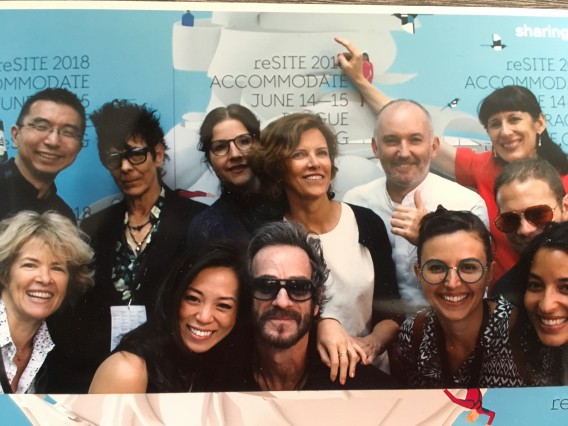
(L-R top: Sou Fujimoto; Elizabeth Streb; Elin Strand Ruin; Jeanne Gang; Martinn Barry; Radka Ondrackova. Bottom: Laura Flanders; Dara Huang; Michel Rojkind; Solene Wolff; Christine Nieves.)
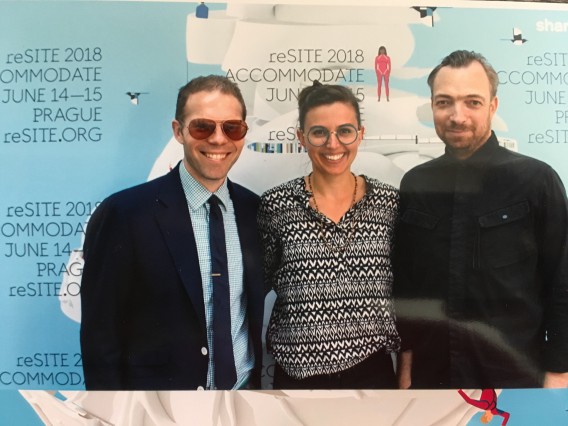
(L-R: Solene Wolff; Liam Young)
(My winning hackathon team at MadCity.)
July 04, 2018 | permalink
Last month in Prague, I guest curated and co-hosted the seventh annual edition of reSITE, where the theme this year was housing. A one-minute highlights video is posted above, along with a quick-and-dirty recap of the conference and a few photos are posted below. You can also listen to a special edition of Monocle Radio’s “The Urbanist,” starring Jeanne Gang, Sou Fujimoto, Elizabeth Streb, and Dara Huang.
I’ll only add that the list of speakers also included original (albeit less famous) voices like Christine Nieves and Luis Rodriguez Sanchez of the Puerto Rico-based post-hurricane recovery group Apoyo Mutuo Mariana, Rahul Srivastava and Matias Echanove of the Mumbai-based research collective URBZ; the novelist and journalist Tim Maughan; the architect and filmmaker Liam Young, and many more.
It was exhausting, exhilarating, and humbling all at once – a supposedly fun thing I would definitely do again.
——————————————————————————————————————————————
The 7th annual flagship event reSITE 2018 ACCOMMODATE asked the question of how and where we want to live – and how we will afford it. Nearly 1200 visitors registered for the global forum held on June 14–15, 2018 in Prague, where a global lineup of speakers explored the future of cities and housing. Architects Jeanne Gang, Sou Fujimoto, Michel Rojkind, Reinier de Graaf offered new visions for living together in public space; WeWork, MINI, and Design Haus Liberty presented bold plans for co-living, and dozens of architects, mayors, planners, and investors debated how to solve the global housing crisis.
LSE Cities director Ricky Burdett’s opening keynote framed the challenge succinctly: “Inequality is baked into the design of cities.” What we need, he said, is “convergence – living in the areas where everyone has the same opportunities, not opportunities based on postal code.”
Speakers’ lineup (among others):
Sou Fujimoto, Founder of Sou Fujimoto Architects, JP
Michel Rojkind, Founder of Rojkind Arquitectos, MX
Jeanne Gang. Studio Gang, US
Oke Hauser, Creative Director, Mini Living, DE
Dara Huang, Founder of Design House Liberty, UK
Erion Veliaj, Mayor of Tirana, AL
Darrick Borowski, Creative Director of WeWork and WeLive, US
Anita Roth, Airbnb’s Head of Policy Research, US
Ricky Burdett, Director, LSE Cities, UK
Reinier de Graaf, OMA/AMO, NL
Dan Hill, Arup, UK
Marcus Fairs, founder of Dezeen, UK
Carlota Rebelo, Monocle’s producer and reporter, UK
Rob Bole, General Manager of Citylab, US
For the first time, reSITE hosted lively and popular discussions on its intimate Live Mic Stage. Sou Fujimoto, Jeanne Gang, Ricky Burdett, Dara Huang, Michel Rojkind, and other speakers shared “what I’ve learned” with visitors asking about what happens behind the scenes of their work.
reSITE also hosted the premiere of the drone documentary Elevation. The directorial debut by Dezeen founder Marcus Fairs is an eye-opening odyssey into the future of living and urban design once drones will become as ubiquitous as the Internet. Fairs noted in his commentary that “architects should collaborate with software engineers just as they do with structural engineers.”
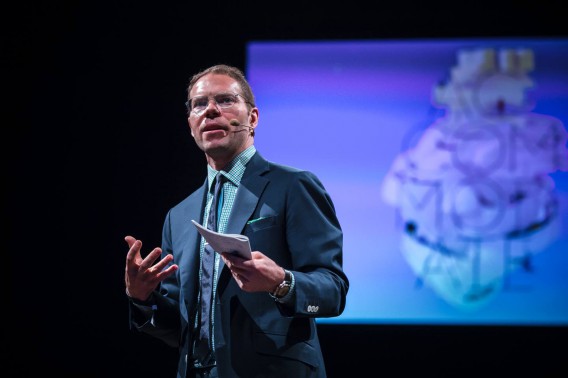
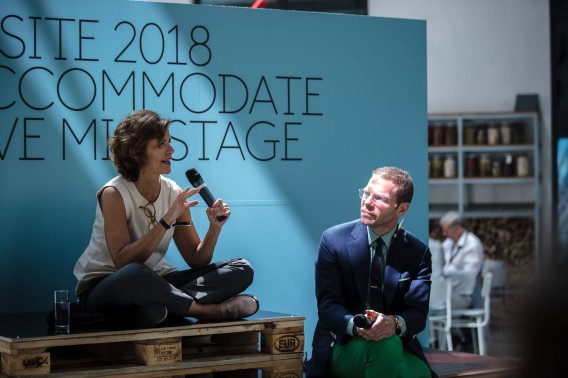
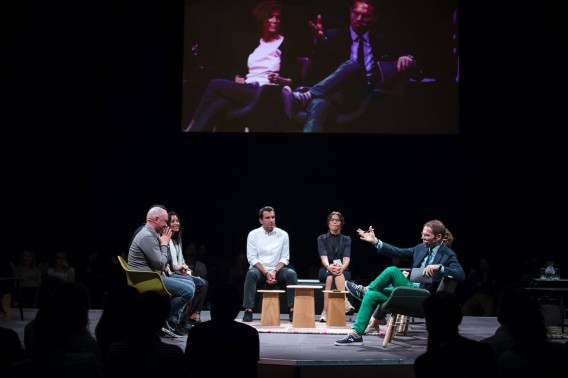
July 04, 2018 | permalink
(The Property Voice, a UK-based podcast series devoted to real estate, interviewed me this spring. I’m unable to embed the audio here, but you can click through to listen on their site, or download an MP3 version. A short recap is below.)
***
Hello, and welcome to another episode of The Property Voice podcast. My name is Richard Brown and as always, it’s a pleasure to have you join me on the show again today.
I am joined on today’s show by Greg Lindsay, who is a journalist, urbanist, futurist, and speaker based out of New York. This week we let the reigns off a bit and venture into discussing the big picture, future housing trends and smart cities within the overall context of PropTech. If you want to know where the money is heading for the future as Greg puts it, then this one is for you! Greg is a very smart and interesting speaker, you will want to hear what he has to say…as much as what he doesn’t say…
The future of housing and how we live…here are some key themes, trends and takeaways from our discussion.
Megatrends can help to drive the future of property & PropTech – the shift to urbanisation, population growth, new mobility, energy-efficiency drives, health needs and technological advancement all featured as having an influence on our future property and housing needs.
Smart Homes & Smart Cities need to be more than just tech toys – Greg made the point several times that smart homes need to be more than an Alexa-enabled facility to be truly useful, such as being a part of micro-power hubs and connected to sustainable transport hubs. He also talked about the dark side of smart homes…
Community living will make a comeback – in pre-industrial times society tended to gather into small communities, which shifted towards individualism and the rise of the family as a community model over the past hundred and fifty years or so. The need to live more closely together and care for the elderly could give rise to greater community-based housing, be that through co-living buildings, inter-generational homes or more user-friendly homes for the elderly in the future therefore.
Technology can help us to connect better in a ‘real-time, real-place way’ – as Greg said, we have a surveillance society not a connected society right now. So, imagine how the technology behind apps like Tinder or Four Square could help to deliver relevant information about the people around us to help enable a sense of community living and camardaery.
Housing delivered as a branded, on-demand, consumer-oriented service offering will increase – several times, Greg made this point of the consumer demanding greater services delivered via different economic, sharing or crowd-based models throughout our discussion. Hospitality delivered by clever brands using new platforms sounds quite different to a landlord renting to a tenant they found on Gumtree doesn’t it?
The economics of real estate will also change – unaffordability, welfare funding and the demand for pay-as-you-use services will give rise to new models of funding and payment of property usage. Crowdfunding, Blockchain, big business or philanthropic-backed micro-communities and the charge by the unit approaches offered by Airbnb and WeWork are all examples of this emerging trend, starting within the commercial sector. In short, we might expect to see homes or properties become more of ‘membership asset model’.
In summary… mobility, liveability and collectively: some large players are now selling off suburban portfolios and instead focusing on the dense urban areas as ‘that’s where the money is’. As I always like to say…follow the money, then finding ways to densify cities seems to be where the money is headed.
June 29, 2018 | permalink
(The APA asked me to appear on their podcast series back in March, despite the fact I’m not, you know, a planner. A good time was had by all regardless. The podcast is embedded above; their description is reproduced below.)
People Behind the Plans is a podcast series from the American Planning Association that explores the business of planning for the built environment. Hosted by Courtney Kashima, AICP, planner and small business owner of Muse Community + Design in Chicago, this podcast series features conversations between planners on work, life, ideas, and problem-solving in a variety of communities.
Courtney welcomes to the podcast Greg Lindsay, who visited Chicago in March for the 2018 National Shared Mobility Summit, and the two grapple with how developments in technology are radically changing cities and affecting the work planners do across the country. As a journalist, urbanist, futurist, and speaker, Greg thinks constantly about cities, and he argues that we’ve chosen to make living in the dense urban core a luxury good. Greg is also a senior fellow at NewCities and the director of strategy of its offshoot LA CoMotion – an annual urban mobility festival in the Arts District of Los Angeles – as well as the coauthor of the book Aerotropolis: The Way We’ll Live Next, which Courtney and Greg discuss. The phenomenon of co-working and co-living spaces, tactical urbanism, and the equity implications of certain technologies also make their way into this dynamic conversation.
June 18, 2018 | permalink
I was in Venice this weekend to belatedly tour the Venice Architecture Biennale (best pavilions: the Netherlands, Korea, and Ireland) and to visit my own small contribution with “Bight: Coastal Urbanism”, which is installed at the Palazzo Mora as part of the European Cultural Centre’s ““Time, Space, Existence” exhibition. Cheers to my teammates Rafi Segal, Susannah Drake, Sarah Williams, Brent Ryan, and Benjamin Albrecht!
June 06, 2018 | permalink
Smart Cities New York has posted the video from my session last month on autonomous vehicles, starring Ali Chaudhry (Deputy Secretary for Transportation to Governor Andrew M. Cuomo); Gretchen Effgen (Vice President of Partnerships and Team Business, nuTonomy Inc.); David Mindell (CEO and Founder, Humatics Corporation), and Wessel van der Pol (Sales Engineer, 2getthere). Please click above to watch the entire thing.
June 04, 2018 | permalink
I was in Riga (Latvia) last week for the second edition of MadCity, my favorite scrappy European cities conference now that reSITE is all grown up (more on that next week). Given the theme “Money and the City,” I decided to riff on an idea that I’ve been turning over in my mind for a while – and will bring up at URBAN-X’s “Where the Robots Meet the Road: Pay to Pave” on June 4 – which is the temptation to take a good idea in a relatively analog world, congestion pricing, and apply it too far in an autonomous one. I can’t seem to embed the video, but click through on the image above to watch.

» Folllow me on Twitter.
» Email me.
» See upcoming events.

Greg Lindsay is a generalist, urbanist, futurist, and speaker. He is a non-resident senior fellow of the Arizona State University Threatcasting Lab, a non-resident senior fellow of MIT’s Future Urban Collectives Lab, and a non-resident senior fellow of the Atlantic Council’s Scowcroft Strategy Initiative. He was the founding chief communications officer of Climate Alpha and remains a senior advisor. Previously, he was an urban tech fellow at Cornell Tech’s Jacobs Institute, where he explored the implications of AI and augmented reality at urban scale.

----- | January 22, 2024
The Future of Generative AI in Architecture, Engineering, and Construction
----- | January 1, 2024
----- | August 3, 2023
CityLab | June 12, 2023
Augmented Reality Is Coming for Cities
CityLab | April 25, 2023
The Line Is Blurring Between Remote Workers and Tourists
CityLab | December 7, 2021
The Dark Side of 15-Minute Grocery Delivery
Fast Company | June 2021
Why the Great Lakes need to be the center of our climate strategy
Fast Company | March 2020
How to design a smart city that’s built on empowerment–not corporate surveillance
URBAN-X | December 2019
CityLab | December 10, 2018
The State of Play: Connected Mobility in San Francisco, Boston, and Detroit
Harvard Business Review | September 24, 2018
Why Companies Are Creating Their Own Coworking Spaces
CityLab | July 2018
The State of Play: Connected Mobility + U.S. Cities
Medium | May 1, 2017
Fast Company | January 19, 2017
The Collaboration Software That’s Rejuvenating The Young Global Leaders Of Davos
The Guardian | January 13, 2017
What If Uber Kills Public Transport Instead of Cars
Backchannel | January 4, 2017
The Office of the Future Is… an Office
New Cities Foundation | October 2016
Now Arriving: A Connected Mobility Roadmap for Public Transport
Inc. | October 2016
Why Every Business Should Start in a Co-Working Space
Popular Mechanics | May 11, 2016
Can the World’s Worst Traffic Problem Be Solved?
The New Republic | January/February 2016

January 31, 2024
Unfrozen: Domo Arigatou, “Mike 2.0”
January 22, 2024
The Future of Generative AI in Architecture, Engineering, and Construction
January 18, 2024
The Promise and Perils of the Augmented City
January 13, 2024